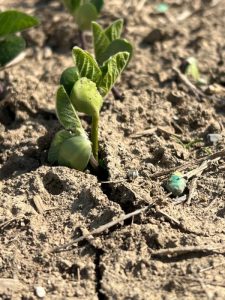Agronomy, Homepage Slider, Soybean Quality
Soybean Tips for Late Planting and Replant
By Dusty Sonnenberg, CCA, Ohio Field Leader, a project of the Ohio Soybean Council and soybean checkoff.
With the wet spring weather, the results of soybean planting across Ohio have been mixed. A quick tour across the state will show that there are some areas that the beans went in early and look very good, and there are other fields that were planted and had flooding or soil crusting issues, and there are still fields that have not been planted.
“I traveled in both Northeast and Northwest Ohio last week, and across the state in general the soybeans are behind,” said Dr. Laura Lindsey, OSU Extension Soybean and Small Grain Specialist. “I had some pictures sent to me of soybeans that were pale and had poor root growth, and the field looked like it had been saturated with water. Sometimes these soybeans that don’t grow as well and have poor root growth and are yellow in color are often time an indication of saturate soil conditions. The hope is that the soils will dry out and warm up and the soybeans will pull through.”
Planting population and row spacing are two factors to consider when making late planting and replant decisions. “Row spacing is always important,” said Lindsey. “We like to see narrower rows, either 15 inch or 7 ½ inch rows for soybeans regardless of the planting date. This becomes more important the later the planting date becomes for canopy closure and to maximize the capture of sunlight energy to increase yield. We also recommend that farmers increase their seeding rate to 200,000 to 250,000 when planting from the middle of June to the beginning of July.”
A suggested relative maturity when planting from June 15th to June 30th in Northern Ohio is a 3.1 up to 3.5 bean. “This may seem higher than many farmers would consider, but the idea is that we want the plant to grow vegetatively as much as possible before vegetative growth is slowed by flowering,” said Lindsey. “That vegetative growth will help produce nodes, and the nodes will become flowers and then pods.”
When it comes to assessing a field for a possible replant, the threshold may be much lower than most farmers realize. “We recommend farmers do a stand count across several parts of the field to get a good representation of what the emerged population is before making a decision to replant,” said Lindsey. “It is best to wait until the VC to V1 growth stage to make an assessment. In general, we don’t recommend replanting soybeans until a stand is less than 50,000 plants per acre. That may seem extremely low, but once the weather corrects itself, those plants remaining will branch out and can compensate for the lower population.”